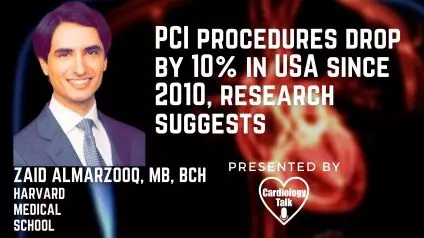Zaid Almarzooq, MB, BCh @ZaidAlMarzooq @BringhamWomens @harvardmed @SmithBIDMC @rwyeh #PCI #PercutaneousCoronaryInter...
Zaid Almarzooq, MB, BCh, Fellow in Cardiovascular Medicine at Brigham and Women's Hospital speaks about PCI Procedures Drop By 10% In USA Since 2010, Research Suggests.
Link to Article:
https://cardiovascularnews.com/pci-procedures-drop-by-10-in-usa-since-2010-research-suggests/
The findings are published in a study letter by Zaid Almarzooq (Harvard Medical School, Boston, USA) and colleagues, who also observe that elective PCI has shifted from inpatient to outpatient settings.
According to Almarzooq and colleagues, myocardial infarction (MI) rates have decreased in the United States as a result of advances in preventative treatment, and more recent randomized studies have validated the role of medical therapy in the first management of stable ischemic heart disease.
The researchers used the Healthcare Cost and Utilization Project State Inpatient Databases and State Ambulatory Surgery and Services Databases to find patients who had PCI between January 2010 and December 2017 in Florida, Michigan, Maryland, and New York.
Procedures were categorized as either urgent or elective depending on whether they were performed in the context of a MI (either ST-elevation or non-ST-elevation MI). Using state population denominators provided from the US Census Bureau, overall population rates of PCI were calculated and then stratified by indication (urgent or elective) and setting (inpatient or outpatient).
The researchers discovered that 1,044,698 PCIs were done in the entire study cohort (333,819 patients [32 percent] female; mean [SD] age, 65.7 [12.2] years) (448,571 [42.9 percent ] were urgent, and 596,127 [57.1 percent ] were elective).
PCI rates fell from 260.2 per 100,000 to 232.8 per 100,000 between 2010 and 2017, according to the researchers (p for trend 0.001). This was mainly due to a reduction in elective PCI rates from 165.3 per 100,000 to 123.6 (34.4%; p for trend0.001), whereas urgent PCI rates increased from 95 per 100,000 in 2010 to 109.2 (+15 percent; p for trend0.001).
Elective PCI rates decreased by 23.8 percent between 2010 and 2013 (p for trend 0.001), after which they remained constant (+1.9 percent; p for trend =0.496). When PCI rates were stratified by inpatient vs. outpatient environment, inpatient PCI rates fell from 226.4 per 100,000 to 166.2 (26.6%; p for trend 0.001), whereas outpatient PCI rates rose from 33.8 to 66.7 (+97.1%; p for trend 0.001).
Randomized clinical trials, such as the COURAGE trial, have emphasized the role of medical therapy in the management of stable ischaemic heart disease compared to PCI, according to Almarzooq and colleagues, though they note that the decline in PCI rates observed in prior years after the publication of the COURAGE trial has since stabilized.




